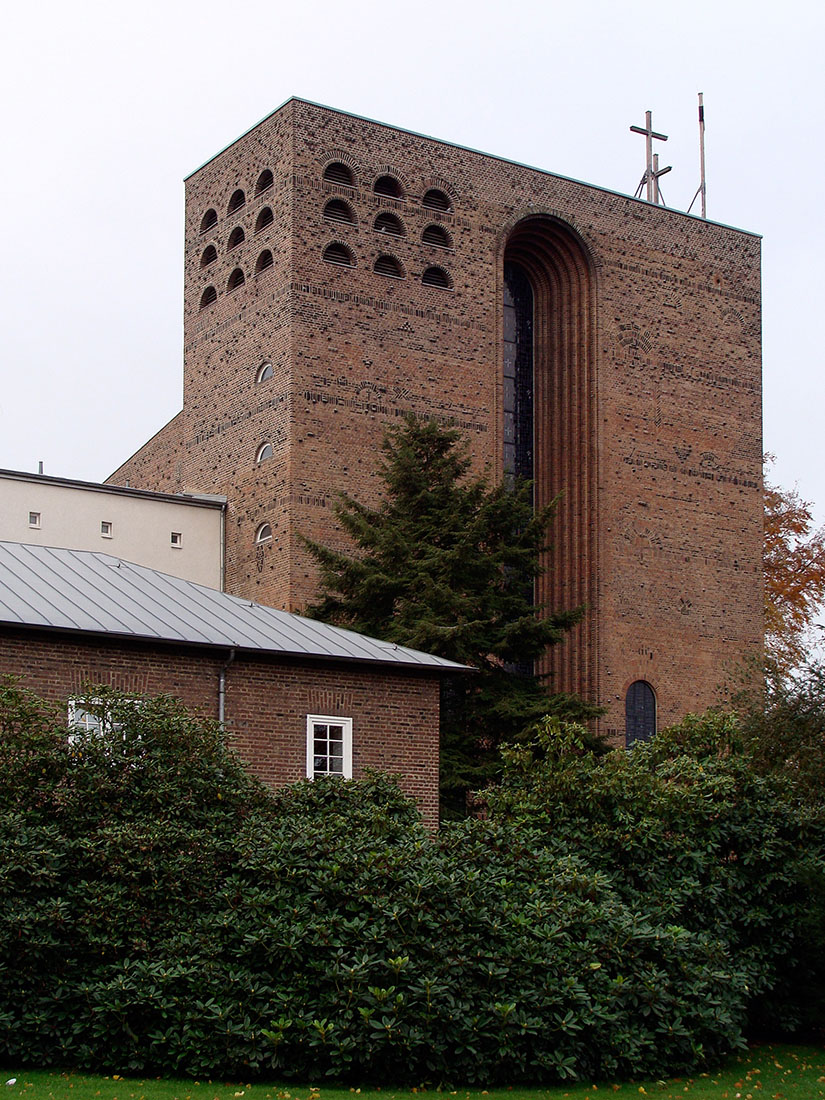 |
 |
 |
 |

Cloister and Church St. Kamillus
Kamillianerstr. 40-42, Mönchengladbach
1928 - 1931
Dominikus
Böhm had already been working for the Order of Camillians in
Hindenburg. In 1928 he received a commission to build a home for
elderly people
with associated monastery and church for the headquarters of the order in Mönchengladbach. In accordance with the religious thoughts of the order,
the hospital was built instead of the old people's home from April 1929 onwards. Only one year later, the St. Camillus Church was built. The complex consisted
of the recessed church in an elevated position, an attached two-storey building for the monastery and a four- to five-storey hospital with white plastered facades.
The hospital on an L-shaped floor plan bordered directly to the monastery on two sides. Today, the appearance of the whole complex is severely affected
by subsequent modifications and additions.
The plan of the church corresponds to a simple rectangle with seamless attached semicircular apse. The clearly structured nave is preceded on the west
side by a high entrance tract in the form of a vertical standing cube. The façade of this monumental western volume is dominated by a group of three arched windows.
The middle of these windows is of an impressive size and has a stepped soffit. In addition, one corner of this distinctive volume is pierced by several small semicircular
openings working as sound arcades. The monumentality of the facade is even further exaggerated by the wide staircase in front of it. This western volume is the highest point
of the whole complex and is visible from afar. Behind this volume, the roof drops in a gentle slope continuously to the choir. In this way, the lowest point of the space is
above of the altar, which is surrounded by tall windows in a semicircular arrangement. Thus the altar is at the same time the brightest place in the church.
The windows of the entrance side are are made of vividly colored stained glass, so that the light of the church pours in mainly from the side of the altar.
with associated monastery and church for the headquarters of the order in Mönchengladbach. In accordance with the religious thoughts of the order,
the hospital was built instead of the old people's home from April 1929 onwards. Only one year later, the St. Camillus Church was built. The complex consisted
of the recessed church in an elevated position, an attached two-storey building for the monastery and a four- to five-storey hospital with white plastered facades.
The hospital on an L-shaped floor plan bordered directly to the monastery on two sides. Today, the appearance of the whole complex is severely affected
by subsequent modifications and additions.
The plan of the church corresponds to a simple rectangle with seamless attached semicircular apse. The clearly structured nave is preceded on the west
side by a high entrance tract in the form of a vertical standing cube. The façade of this monumental western volume is dominated by a group of three arched windows.
The middle of these windows is of an impressive size and has a stepped soffit. In addition, one corner of this distinctive volume is pierced by several small semicircular
openings working as sound arcades. The monumentality of the facade is even further exaggerated by the wide staircase in front of it. This western volume is the highest point
of the whole complex and is visible from afar. Behind this volume, the roof drops in a gentle slope continuously to the choir. In this way, the lowest point of the space is
above of the altar, which is surrounded by tall windows in a semicircular arrangement. Thus the altar is at the same time the brightest place in the church.
The windows of the entrance side are are made of vividly colored stained glass, so that the light of the church pours in mainly from the side of the altar.
